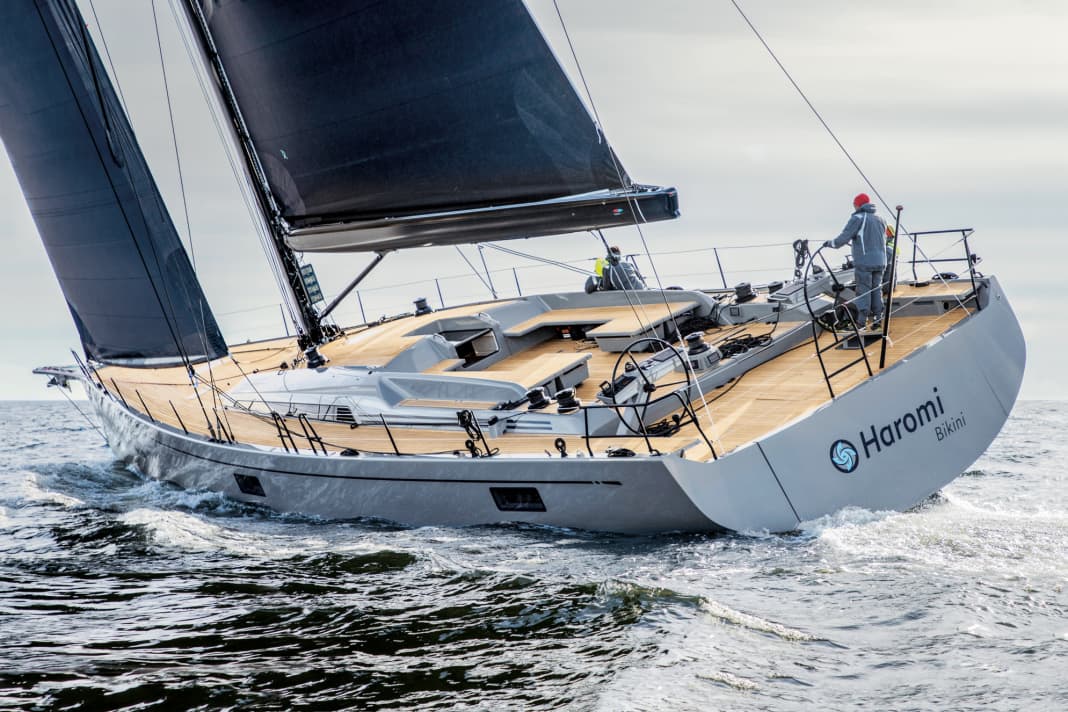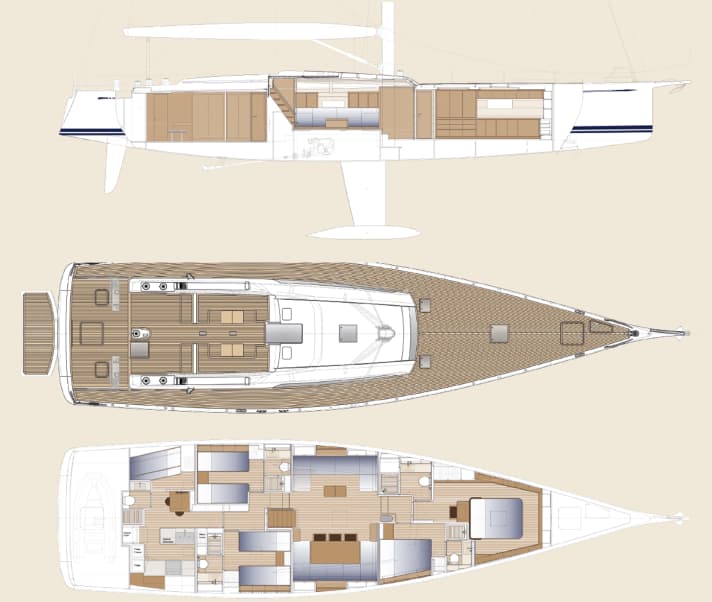





The dominant colour in the Finnish summer is green. 400 kilometres north of Helsinki, you would be forgiven for thinking that 70 percent of Finland is covered in forest. The Nautor harbour basin is truly colourful. On the left, a classic white and blue 115 checks in for refit in Pietarsaari. On the right, a dark blue 54 ready for delivery next to a green 60. Opposite, the original Swan 36 "Tarantella" from 1966, in white and with the famous blue stripes. In the middle and almost at freeboard level with the 115 is the Swan 78: steel grey hull with black carbon rigging, shiny golden teak deck and the brand stripes on the coaming. At Nautor, the 78 is known as "the biggest of the small and the smallest of the big". She is now the link between the maxis and the small, mostly crewless Swans under 20 metres. It was only logical to start the line conversion with her.
"Haromi's" sides rise steeply and far upwards, the vertical stem merges into a long waterline and a stern that is almost as open as that of the ClubSwan 50. "This hull gives us significantly more space below deck," Germán Frers answers dryly when asked what triggered this change in shape. And adds: "You have to move with the times." He, who designed his first sailing yacht at the age of 17 and has been drawing Swans for over 40 years, is reinventing himself? Not quite.
Construction accurate to the centimetre
The 78 radiates the indispensable Frers elegance and timelessness. Nowhere is one centimetre too much. And from a purely constructive point of view, the aft-projecting hull is a consequence of the specification requirement for a twin rudder to reduce rudder pressure and increase redundancy. The more inclined transom, which in the neighbouring Swans merges round into the deck and further into the flounder superstructure, was omitted. A side effect of the jumbo stern: it favours a tender garage in which a dinghy up to 4.60 metres in size can be rotated using a patented device.
Even with the new models - the 78 was followed by the 65 and 98 - owners no longer have the choice between a centre cockpit (owner's cabin forward) and aft cockpit (owner's cabin aft). Depending on the layout, the deck came from a separate mould. With the new Swanline, the Italian-run shipyard only needs one mould each for the hull and deck, which are laminated in GRP and prepreg carbon fibre. The platform construction reduces both price and delivery times. Three 78s are expected to leave the Boatbuilding Technology Centre (BTC) in Pietarsaari each year. The two-in-one layout was made possible by the new coachroof, which could already be seen in a very similar form on the first Wally 80 - "Genie of the Lamp".
In 1995, the Argentinian launched a true flush deck revolution with the stub superstructure far behind the mast. On the "Haromi", unlike on most minimalist schierdeckers, the coachroof encloses the mast. In the original design briefing, the mast was to be positioned in front of the coachroof before a modified sail plan moved both aft as a single unit. During the first interior mock-up, Frers realised that the saloon was too small and extended the length of the superstructure. The mast protruding into the living area thus became a carbon-fibre reminder that "Haromi", for all her interior excellence, was designed for racing.
Swan 78 available in different layout variants
All owners of the four 78 units already sold opted for the forward cabin with a large double bed in the bow. In this layout variant, the crew cabin, navi-corner and galley are moved aft, offering the crew a high level of comfort on long passage trips and short distances during regattas. Aft of the saloon are two double guest cabins, which remain in the same position when the owner's flat is aft. Swan designed the interior together with the "maestro", as Nautor employees call Germán Frers internally. "The best thing about Swan is what you don't see straight away" - another cliché-sounding motto, if it didn't come from the mouth of a Finn.
Because they are considered to be thoroughly honest and extremely conscientious boat builders. The visible quality is right from the deck to the bilge, where every centimetre is accessible. Ceiling panels and sound-absorbing metal plates hanging on vibration pins have to be unscrewed to reach the halyards and stretchers. Solid, leather-wrapped handrails provide the necessary support, even in rough seas. The front and rear frames are tightly sealed, an important safety aspect for Nautor for many years. Stephan Semmerling, the extremely active representative of the German owner, had larger tanks and lithium-ion batteries installed, which enable a day of sailing fun without generator support. Thanks to the telescopic keel, the 140-kilowatt Steyr tiller moves under the saloon floor, where it operates quietly. The engine is accessible via floor plates and a door behind the companionway.
Swan 78 is more racer-cruiser than the other way round
At 42 tonnes, "Haromi" is not really a lightweight. On the Alholmsfjärden, however, the 23.99 metre long sloop starts surprisingly quickly. In winds of up to ten knots, she easily surpasses the true wind speed under genoa. Following the trend towards multiple headsails, a gennaker or code zero, jib and a staysail can be attached to the Southern Spars carbon mast. Even upwind, the rudder pressure is surprisingly low. It is pleasant that the steering feel becomes more direct the stronger the heel. The ideal angle is 20 degrees. Then the windward rudder blade protrudes completely and generates no water resistance.
There is a simple reason why the first Swan 78 is more of a racer-cruiser than the other way round: owner's representative Stephan Semmerling was given carte blanche when it came to choosing the additional equipment. "We took it to the extreme," says Semmerling with a laugh, leaning visibly satisfied against the backstay. At his behest, the bowsprit was made longer and "Haromi" was fitted with two additional winches on the mast and one for the mainsheet in the centre in front of the steering wheels.
These three winches are captive in the second, less sporty construction number and work below deck. The Harken carbon winches drive cranks in ORC regattas. In hydraulic mode, up to four run at full speed at the same time without the oil running hot. "It is cooled in a circuit with pre-pressurisation," says Semmerling happily. He, who saw himself as an active developer in this project, ordered trim panels for the mainsail and headsail winches, which are located in the centre of the steering wheel in the standard version. The sail laminate was ordered from Quantum Sails by the owner with racing ambitions, who also ordered a wide mainsail, which is travelling to the Rolex Swan Cup in Porto Cervo in a 40-foot container.
Conservative comfort
Germán Frers walks through the cabins after being on board for six hours in an outside temperature of ten degrees, opens a locker here, checks a puttering there and tests the plastic-covered owner's bed extensively. He would choose the aft owner's area.
"More privacy", says the grand seigneur in the harbour. In both layouts, the seats recessed into the coaming are dedicated to comfort without exception. Nobody would sit here during a regatta. Old values, new shapes - that's how you could describe Nautor's line conversion. This statement backs it up: "We are very conservative. The only room for craziness is the colour of the hull."
Technical data of the Swan 78 "Haromi"
- Length over everything:23,99 m
- Length WL:22,18 m
- Width:6,40 m
- Depth:3,00-4,40 m
- Displacement (slight):42 t
- Ballast:11,6 t
- Material:GRP, carbon
- Motor:Steyr 140 kW
- Generator:Onan 19 kW
- Fuel:2.000 l
- Water:1.300 l
- Mainsail:180/200 square metres
- Jib:160/174 m²
- Staysail:82 m²
- Code Zero:245 m²
- Gennaker A3:520/610 m²
- On-board electronics:B & G
- Construction:Germán Frers
- Styling:Germán Frers
- Interior:Nautor, Germán Frers
- Design category:A

This article first appeared in BOOTE Exclusive issue 5/2018 and has been updated for this online version.
More from the shipyard:
- SWAN 108: Nautor heralds a new maxi era
- "ODIN":Swan 115 with regatta ambitions
- SWAN 55: Beautiful northerner with Italian temperament
- CLUBSWAN 28: Here comes the smallest Swan of all time
- SWAN 65: The cruising yacht with an old spirit and a new look
- SWAN 115 FD: Simply beautiful - 35 metre slup "Shamanna"

